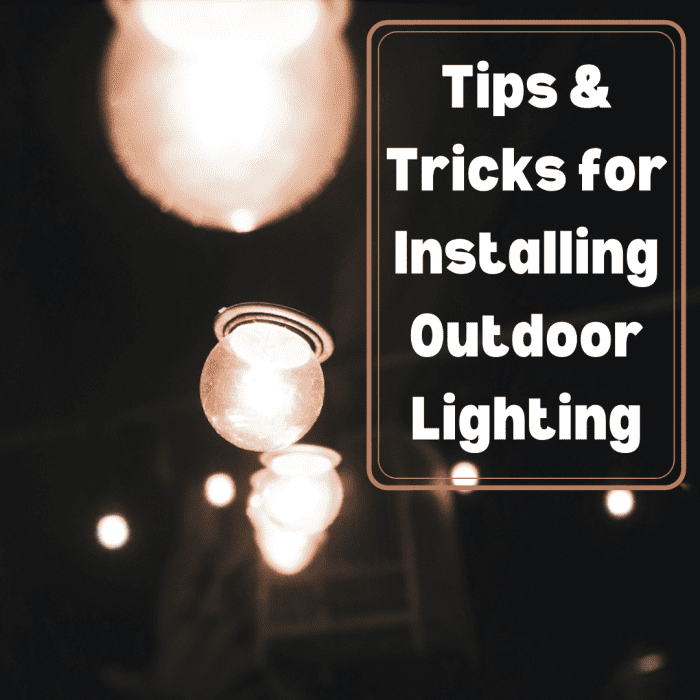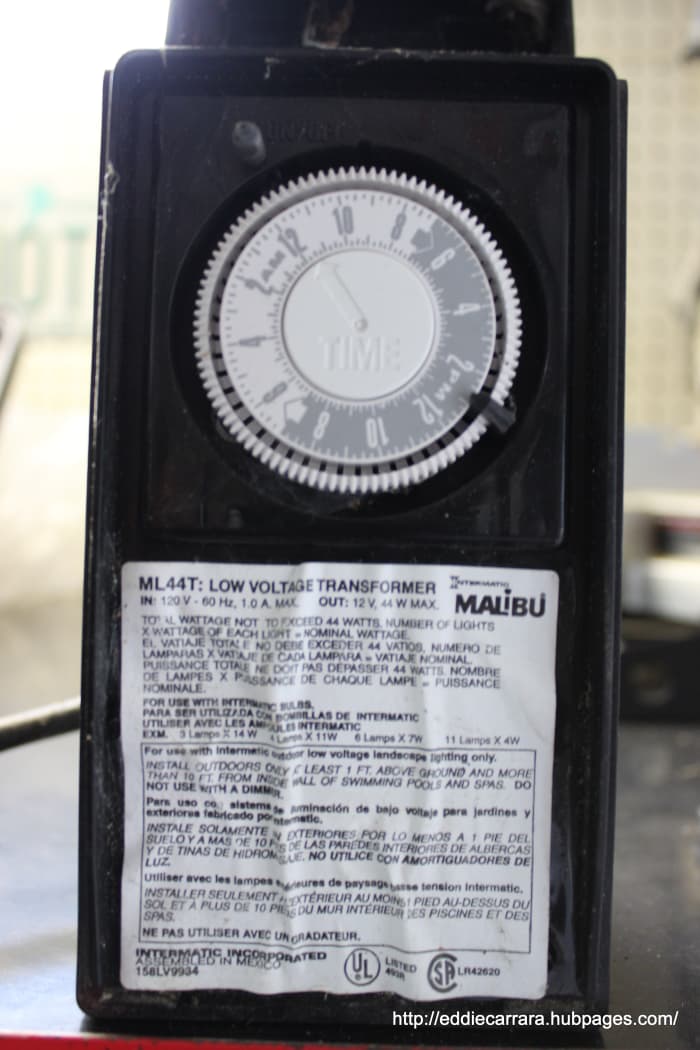How To Install Star Shower Laser Lights
25 years in the auto business & hiking a lot with my kids (who have a knack for getting sap everywhere) has taught me how to deal with sap.

This article teaches important tips for installing low-voltage outdoor lighting
Mikael Frivold | Unsplash
Unusual Low-Voltage Outdoor Lighting Installation Tips
The outdoor lighting installation tips I will cover here are not usual for low-voltage landscape lighting, and you probably won't find them on any other website promoting low-voltage outdoor lighting. These are ideas and tips I have developed through trial and error. I believe if you make a mistake, you should learn from it. If you don't, it's called insanity! What I have learned comes from my mistakes, and now I'm sharing what I have learned with you. This article will cover the following topics:
- Buying a low-voltage transformer
- Water-tight wire connections for your outdoor lighting
- Keeping your outdoor low-voltage lighting wires safe
Low-Voltage Lighting Transformers

This is an old school timer, it works and gets the job done, but that's about it.
Eddie Carrara

This is a new style low voltage lighting transformer, it's totally programmable for any situation, it also comes with a photocell.
Eddie Carrara

This a photocell light sensor, it's about the size of a quarter. It's best to buy a low voltage lighting transformer with a photocell so you're not constantly adjusting the timer.
Eddie Carrara
Buying a Low-Voltage Transformer
If you plan on buying individual lights or if you plan on buying a kit, one important question you need to ask yourself is "How will the transformer turn on and off?" Most likely, you don't live in an area of the world where the sun rises and sets at the same time each day, so I recommend buying a transformer that has a photocell light sensor. This type of light sensor turns your outdoor lighting on at dusk and usually has some sort of control so you can adjust how long the lights will stay on. You can set the control so the light will stay on for 4, 6, or 8 hours, or you can also have them come on at dusk and turn off at dawn.
Having this function will save you the hassle of constantly adjusting the on and off times on the transformer. If you purchase a transformer that doesn't have a photocell light sensor, you will probably be adjusting the on time about every 2 months. Remember, I learned this through trial and error. This wasn't a big deal at first, but it wears on you after a few years.
Programmable Low-Voltage Lighting Transformers
Water-Tight Wire Connections for Your Outdoor Lighting
Most do-it-yourselfers will buy a low-voltage outdoor lighting kit the first time around, and it's not a bad choice, but beware of the connectors you get in the kit. The connectors in the kit use a wire piercing type of connector which will only last about a year or two depending on your outside weather conditions. Moisture penetrates the plastic connectors and corrodes the wires and causes a poor connection or worst, high resistance in the wires causing the transformer to overheat and eventually burn out.
I recommend installing heat shrink connectors or heat shrink tubing at all connections. The tubing is easier to use and install and doesn't require any special crimping tools. As you splice the wires to install each light, slide a piece of heat shrink tubing over the wires, twist the stripped wire ends together, and then slide the heat shrink tubing over the bare wires. Once the heat shrink tubing is covering the bare wires, use a heat gun or micro torch to complete the water-tight connection. (See my video on heat shrink connectors and tubing).
Using this method of twisting the wires together is the best practice for outdoor lighting or any wire connection for that matter. It's even better than soldering the wires together because the flux in the solder will corrode the wires over time, causing a poor connection or high resistance in the wires. Homes are wired in this manner. If you have ever replaced a light fixture, you would have noticed the wires are twisted together then capped with a wire nut, I also use this method when repairing automotive wiring. It makes a great connection, and it's permanent.
Water-Tight Connections for Low-Voltage Outdoor Lighting

This is a 20watt low voltage landscape light place at the base of a crab apple tree.
Eddie Carrara

LED solar lights along the side of a pool, they don't really light a path, but put a twinkle on the water.
Eddie Carrara
Keeping Your Low-Voltage Outdoor Lighting Wires Safe
I have a few tips for keeping your landscape lighting wires safe, one tip I'll show you, most do it yourselfers would never think of. When planning your outdoor lighting wire route, place the lights where you would like them, then lay out the wires, try to keep the wires near walkways, driveways, and patios or places where a stray shovel won't encounter the wire. But if you are trying to run a wire out to a tree in the middle of your yard, and you have to pass through the edge of a flower garden where the grass meets the garden, this is a dangerous spot for wiring.
Because low voltage lighting wires only have to be a few inches deep, spring clean up can cause some problems. The garden edges are usually cleaned up and reshaped with a nice sharp shovel or edger, so if your low voltage wires are running to shallow, there's a good chance your light will not be working when you pull into the drive when you get home from work. A simple solution for this common problem is slipping the wire through a piece of thick rubber or pvc tubing where the wire enters the garden from the grass, this will help protect the wire from that nasty ole shovel, you can also add this wire protector at any other place you feel a shovel might damage the wires.
Please take a second to vote.
This article is accurate and true to the best of the author's knowledge. Content is for informational or entertainment purposes only and does not substitute for personal counsel or professional advice in business, financial, legal, or technical matters.
Kristen Howe from Northeast Ohio on August 11, 2015:
Read More From Dengarden
My pleasure Eddie. I like your ideas, since it's useful.
Eddie Carrara (author) from New Hampshire on August 10, 2015:
Thanks Kristen,
I like 12v landscape wired lighting far better then the new LED wireless lights, and I figured I'd share some of the problems I ran into that you can avoid :) Thanks for the read and the vote Kristen.
Kristen Howe from Northeast Ohio on August 09, 2015:
Eddie, this was very useful to know how to install outdoor lightning for your garden landscape. Voted up!
Eddie Carrara (author) from New Hampshire on February 19, 2014:
Thanks ichanz, I appreciate the feedback :)
Ikhsan Sussanti from Panumbangan on February 17, 2014:
it's a useful tips. may be i will try this tips!
nice information
Eddie Carrara (author) from New Hampshire on January 01, 2013:
Hey Austinstar,
With your knowledge, you could pull something like this off, no problem! Thanks for the comment :)
Lela from Somewhere near the heart of Texas on January 01, 2013:
I would love to be savvy enough to do this.
Eddie Carrara (author) from New Hampshire on July 31, 2012:
Thanks Tirelesstraveler, I have had my fair share of wiring problems with my outdoor lighting, but not anymore since I changed the connections to heat shrink tubing :)
Judy Specht from California on July 30, 2012:
Love the idea of outdoor lighting ; it is in the landscape plan. Very good tips on how to place out door lights.
How To Install Star Shower Laser Lights
Source: https://dengarden.com/home-improvement/Outdoor-Lighting-Installation-Tips
Posted by: jacksonrometh.blogspot.com

0 Response to "How To Install Star Shower Laser Lights"
Post a Comment